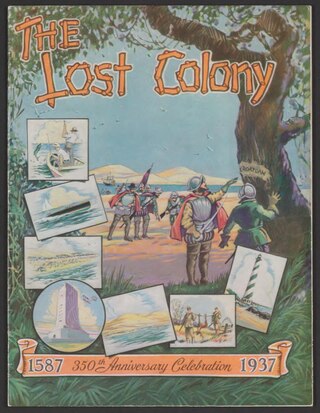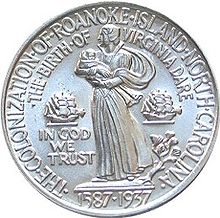
John White was an English colonial governor, explorer, artist, and cartographer. White was among those who sailed with Richard Grenville in the first attempt to colonize Roanoke Island in 1585, acting as artist and mapmaker to the expedition. He would most famously briefly serve as the governor of the second attempt to found Roanoke Colony on the same island in 1587 and discover the colonists had mysteriously vanished.

Roanoke Island is an island in Dare County, bordered by the Outer Banks of North Carolina. It was named after the historical Roanoke, a Carolina Algonquian people who inhabited the area in the 16th century at the time of English colonization.

Roanoke Colony was an attempt by Sir Walter Raleigh to found the first permanent English settlement in North America. The colony was founded in 1585, but when it was visited by a ship in 1590, the colonists had inexplicably disappeared. It has come to be known as the Lost Colony, and the fate of the 112 to 121 colonists remains unknown.

Manteo is a town in Dare County, North Carolina, United States, located on Roanoke Island. The population was 1,602 at the 2020 census. It is the county seat of Dare County.

Hatteras Island is a barrier island located off the North Carolina coast. Dividing the Atlantic Ocean and the Pamlico Sound, it runs parallel to the coast, forming a bend at Cape Hatteras. It is part of North Carolina's Outer Banks and includes the communities of Rodanthe, Waves, Salvo, Avon, Buxton, Frisco, and Hatteras. It contains the largest part of the Cape Hatteras National Seashore. Prior to European settlement the island was inhabited by Croatoan Native Americans.

Ananias Dare was a colonist of the Roanoke Colony of 1587. He was the husband of Eleanor White, whom he married at St Bride's Church in London, and the father of Virginia Dare, the first English child born in America. The details of Dare's death are still unknown.

Fort Raleigh National Historic Site preserves the location of Roanoke Colony, the first English settlement in the present-day United States. The site was preserved for its national significance in relation to the founding of the first English settlement in North America in 1587. The colony, which was promoted and backed by entrepreneurs led by Englishman Sir Walter Raleigh, failed sometime between 1587 and 1590 when supply ships failed to arrive on time. When next visited, the settlement was abandoned with no survivors found. The fate of the "Lost Colony" was a celebrated mystery, although most modern academic sources agree that the settlers likely assimilated into local indigenous tribes.

The Croatan were a small Native American ethnic group living in the coastal areas of what is now North Carolina. They might have been a branch of the larger Roanoke people or allied with them.
Eleanor Dare of Westminster, London, England, was a member of the Roanoke Colony and the daughter of John White, the colony's governor. While little is known about her life, more is known about her than most of the sixteen other women who left England in 1587 as part of the Roanoke expedition.

The Lost Colony is an historical outdoor drama, written by American Paul Green and produced since 1937 in Manteo, North Carolina. It is based on accounts of Sir Walter Raleigh's attempts in the 16th century to establish a permanent settlement on Roanoke Island, then part of the Colony of Virginia. The play has been performed in an outdoor amphitheater located on the site of the original Roanoke Colony in the Outer Banks. More than four million people have seen it since 1937. It received a special Tony Honors for Excellence in Theatre award in 2013.

The Rising Shore - Roanoke is a novel about the Lost Colony of Roanoke Island by Deborah Homsher. The story of the Lost Colony is one of America's first great mysteries. Historically, John White, the leader of the venture, sailed home to London for supplies and then returned three years later to find no trace of the hundred colonists he'd left in Virginia except the word "Croatoan" carved in a post.

Wraiths of Roanoke, is a 2007 Syfy original supernatural period horror film, directed by Matt Codd and stars Adrian Paul, Frida Farrell, Rhett Giles, Michael Teh, and George Calil.
Manteo was a Croatan Native American, and was a member of the local tribe that befriended the English explorers who landed at Roanoke Island in 1584. Though many stories claim he was a chief, it is understood that his mother was actually the principal leader of the tribe. This leadership would not have automatically passed down to her children as many English at the time may have assumed.
The Hatteras Histories and Mysteries Museum focuses on the possible fate of the inhabitants of the Roanoke Colony, who disappeared around 1587. Located in Buxton, North Carolina, the privately owned museum was opened in April 2010 by Scott Dawson, a historian and author of the 2009 book Croatoan: Birthplace of America.

The Secotans were one of several groups of Native Americans dominant in the Carolina sound region, between 1584 and 1590, with which English colonists had varying degrees of contact. Secotan villages included the Secotan, Aquascogoc, Dasamongueponke, Pomeiock (Pamlico) and Roanoac. Other local groups included the Chowanoke, Weapemeoc, Chesapeake, Ponouike, Neusiok, and Mangoak (Tuscarora), and all resided along the banks of the Albemarle and Pamlico sounds. They spoke Carolina Algonquian language, an Eastern Algonquian language.

Louisa Lander (1826–1923) was a member of the expatriate community of American women sculptors who settled in Rome in the mid-nineteenth century, led by Charlotte Cushman and Harriet Hosmer. Lander was ostracized from this community in 1859 due to a rumored personal scandal, and many of the details of her later life remain unknown.

The Dare Stones are a series of stones inscribed with messages supposedly written by members of the lost Roanoke Colony, allegedly discovered in various places across the Southeastern United States in the late 1930s. The colonists were last seen on Roanoke Island, off the coast of what is now North Carolina, in August 1587, and the mystery of their disappearance has since become a part of American folklore. The stones created a media circus in the United States, as the public became fascinated with the possible resolution of the Lost Colony's fate.

Sallie Southall Cotten was an American writer and clubwoman, based in North Carolina. She helped to organize the North Carolina Federation of Women's Clubs. She was the organization's fifth president, and wrote the federation's anthem, as well as a history of the federation.

The Roanoke Island, North Carolina, half dollar is a commemorative coin issued by the United States Bureau of the Mint in 1937. The coin commemorated the 350th anniversary of the Roanoke Colony, depicting Sir Walter Raleigh on one side, and on the other Eleanor Dare, holding her child, Virginia Dare, the first child of English descent born in an English colony in the Americas.























